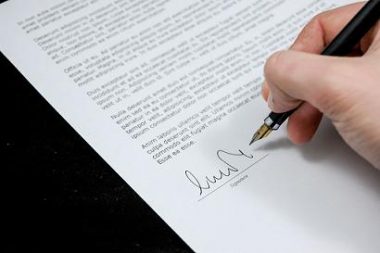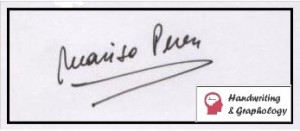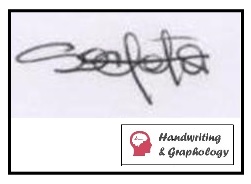Signature Analysis Tips
How do we make a good signature? Today, electronic signatures are becoming valid as a means of identification. What is the future of handwritten signatures? The innovative technologies may be hacked or cloned, while the handwritten signature is the way to grant validity to documents. It is also the summary of the individual’s personality.
The signature and its psychological meaning. How do we make a good signature?
To begin, take a look at the initials of your name and last name and analyze which of the different ways of producing it you like better, so as to make it stand out.
There are many signature models that may help you recognize a few details. Your signature will speak about you more than you can imagine!
The signature is the first name and surname used at the end of a document to confirm it is authentic. Its goal is to identify ourselves. It is even better if we can produce a signature that is “hard to mimic”. This recommendation goes for young people who start signing legal documents such as contracts, driver licenses, passports and bank papers, among others. The fact that these documents are signed is an essential measure in order to certify them.
Banks record their clients’ signatures in their databases and each time we attend to run an errand, employees will have your signature at their computer screen. In case there are great differences between the recorded signature and the one you present, big problems are generated.
For graphology, an individual’s signature is the most genuine expression of their personality. It reveals their virtues, flaws, complexes, ambitions, feelings for inferiority or superiority, capacity for adaptation or tendencies to become lonely.
We should not study a signature in isolation but analyze the signature and text together and look for differences and similarities.
Take a blank sheet of paper and write a few lines that come to your mind and then try your signature. Then compare your signature to the text.
Signature and Text: Similarities and Differences
This analyzes whether the traits of the text are similar to the ones of the signature or whether there are big differences.
It is expected that your signature and the text are similar. It is a sign of coherence between thinking and action. It means that you show yourself the way you are before others, that you are a trustful person who has nothing to hide.
How should the signature of a balanced person be? It is expected that an evolved, mature, and balanced individual signs in a clear, simple and legible way, including characteristics that are similar to the text.
Differences between the signature and text express conflicts in personality and between what the individual wants and what the individual does.
Legibility of your Signature
Is your Signature easy to read?
When young, we believe that an illegible and extravagant signature is more elegant and stylish than our stamped out, plain and clear name. Let us take into account that scrawled signatures are easier to imitate than a clear and full name and last name.
- A signature is legible when the name and last name that appear are easy to recognize. This means that you are a person with clear objectives, who is balanced, who has a sense for responsibility and duty and who feels identified with himself.
- A signature is semi-legible when it is hard to read, but each stroke may be identified with a letter. These kind of signatures are associated to impatience and anxiety.
- Illegible signatures are the ones where it is impossible to identify any letters. There are people who, due to business reasons, sign thousands of times a day, using a short signature. We need to make a distinction in these cases where these scrawls are destined to business, which implies that there is no personal compromise. Illegible signature applied in official IDs only, might show certain difficulty to accept authority.
If the signature is always illegible, it denotes a tendency for avoidance (in order to avoid confrontation) and lack of self-identification. If the signature includes simplified strokes, this means there is a tendency for general summarization and to achieve the goals that have been set.
Name – Last name Relationship
Parts of the signature: The name, from a graphological point of view symbolizes the personal ego and the family ego. It is whom we identify with since we are children and how our family recognizes us. Those who sign with their name only or give more importance to the name than the last name, grant more importance to that first stage of life and to their childish ego.
The father’s last name is related to the paternal image and the social and business ego. It represents authority, paternal role for protection and control as opposed to the mother’s last name (when used) which is granted importance to the maternal image, traditions and the past. When initials of the first and last name only are used, this shows lack of commitment, a desire to avoid responsibility, lack of self-identification and a great capacity for summarization. The signature, which is the scrawl that usually goes together with it, is the frame where the “inner ego” is found.
Also Read: How you cross your “T” ? Handwriting Analysis Letter T
Spaces between Name and Last name
This refers to the distance between the letters and words that compose the name and the last name or last names. Variants are condensed name and last name, signatures of spaced letters and signatures of condensed letters. The distance between name and last name is linked to the psychological bond or separation between what they both represent (name: Personal – family ego, last name: Social ego and maternal – paternal images respectively).
Level of Organization
Signatures are organized when they are constant (traits remain without variation for a considerable time). They are correctly placed in relation to the text (does not cross it, nor it is too far from it), the distance between words and letters is appropriate and the shape of letters is clear. When these parameters are not accomplished we stand before an unorganized signature, and this is how the individual who carries the signature will be: someone showing confusion of ideas, lacking logical order for thinking and not showing themselves the way they really are.
Dimension
In this item we analyze the size of the letters of the signature and the uppercase – lowercase relationship of the signature in the text. The size is related to self-esteem and the concept you have of yourself. There are several possible combinations.
- Letters of the signature are bigger than the ones in the text: People who consider themselves more important than others (more capable, more experienced).
- Signatures done all in uppercase: Serious feelings of superiority along with mythomania. People who are dissatisfied with themselves. They show themselves as superior as a mechanism before their own insecurity in order to hide their weaknesses. Ability to show their best image.
- Letters of the signature and letters of the text are the same size: Their self-concept coincides with what they show.
- Letters of the signature are small compared to the text: Inferiority feelings. Lack of confidence. Shyness.
Types of Signatures: Shape
- Curve- Angle: People whose signature is angle-predominant resist to difficulties, are conclusive, definitive and reluctant to change. They might be intransigent and intolerant. Especially in environments of trust. People whose signatures include curves where angles should appear are softer, sociable, extroverted, affectionate, sensual and with a tendency to laziness.
- Arches- Garlands: Arches reflect movements of defense before the environment. Those who sign with arches, attain to social norms and conventionalisms. They may fall in the artificial and pay more attention to the apparent than the real. Those who sign with garlands transmit spontaneity, kindness and comprehension.
- Simplified- Complicated: According to the degree of complexity, simplified signatures are the ones that include the least amount of strokes and are associated to individuals who use energy correctly. They have ability for summarization and are simple. Complicated signatures imply waste of time, manipulation and lack of clarity in ideas.
- Filiform Signatures: The strokes are thread-like. They denote personalities with diplomatic abilities, who find the solution to any problem and who have a tendency to escape.
- Harmonic- Agitated: According to the level of harmony, they are classified in harmonic signatures, when strokes are fluent, without tensions, equilibrated and calm, as opposed to agitated signatures, where they are conflicting, irregular, tense and convulsive.
- Progression- Regression: Progressive signatures are the once that advance without traits towards the left. It denotes a symbolic altruist movement from the ego situated on the left and the others on the right.
- Regressive signatures: There are strokes to the left, movements of involution that reflect difficult in adaptation, goes back to the past and stop their own development.
Direction of Signature
There should be concordance between the lines of the text and the ones of the signature in a stable person.
- Ascending signatures: They indicate reluctance to difficulties, optimism, ambition, clarity in objectives, self-improvement, fighting spirit. Risks of dissatisfaction.
- Horizontal signatures: They reflect emotional stability. Satisfaction about the present situation.
- Descending signatures: They are associated with discouragement, to lack of energy to get to the desired objectives, discouragement, lack of self-confidence and insecurity that might lead to depression. Also, associated with acceptance of authority, locking into their own ideas. Descending lines may also appear due to mental fatigue.
- Ascending and descending signatures: They may indicate ciclotimia
Slant
Inclination is related to expression of feelings and emotions.
- Signature inclined to the right: Affectionate person, who takes initiatives.
- Vertical signature: Emotional self-control.
- Inverted signature: When the signature is inclined to the left, it indicates for these individuals it is hard to give themselves emotionally, due to protection or to childhood experiences.
It is interesting to analyze the differences in inclination between the signature and the text. When the text is inclined to the right and the signature to the left or vice versa, given that interpretations vary.
Speed
The speed with which we sign is related to the velocity of mental processes and the dynamism of the person.
- Fast signatures: Are from people who need to get to objectives quickly, who are impatient, expeditious, who are resolved and not very reflexive.
- Slow signatures: Calm people that are able to wait to get what they want.
Pressure
The pressure in writing is related to vital energy and the inner-strength in individuals.
In signatures, pressure reveals security and inner-energy. When pressure is limited we need to compare to the pressure in the text. It denotes a weak, shy and inhibited individual, who is prone to diseases due to lack of energy.
Connection
Cohesion is the union and disunion between the letters of the signature and is related to the coherence between thinking and action. “Thinking” and “doing” is also related to sociability.
- Connected signatures: Are the ones where uppercase and lowercase are connected (T,P,V,W,N excluded)
- Disconnected signatures: As a first measure, we need to make sure that the pen has been lifted from the paper to consider dissociation. Juxtapositions may also appear. Predisposition to isolation. Difficulty to sustain what is being done.
What is the Difference between Signature and Rubric?
The signature is the name and surname that we usually place at the end of a letter or some document with the goal of legitimating it. It is the insignia of our personality. The image that represents us before others and which we feel identified with. The analysis of the signature, always along with the text, allows us to discover personal and professional abilities of the writer, their temper, mood, and evolution of their personality throughout life.
The rubric, from Latin terminology rubrum, was born in the antique documents of the Middle Age, to which the Latin words scripsit firmavit recognovit, which mean written, signed recognized, were added in order to legalize them.These words started to deform and turned illegible, persisting in the form of lines or scrawled drawings that appear next to signatures.
Rubric is a line or set of lines added to the name to sign that individualize the signature of each person. In the signature analysis, rubrics reveal personal ambitions. There is no valid calligraphy for rubrics. We try to avoid that our signature is adulterated easily and that is why we usually look for rubrics that not only appear next to and decorates the signature, but also that are not easy to counterfeit. There are people who do not “rubric” and who tangle the signature with the rubric. There are rubrics that persist along the years, that are constant and others that change with time, that fade out. Each one has a different interpretation.
Psychological Interpretation
Some authors comment that rubrics are “walkers” of personality. Something like a walking stick or support of which we get rid of as our personality matures. In rubrics, the ego defense mechanisms are revealed, which are the ones that protect the ego. In the signature, the name gets bigger, it becomes more legible and clear and the rubric gets simpler or smaller.
The evolution of the signature and rubric should go from “childish complication” and “inferiority complex” to “self-improvement and maturity”. Simplification of the rubric symbolizes personal achievement, mental maturity and a consolidated personality. That is why we say “the less rubric, the more personality”.
Underlining your Signature
Rubrics are analyzed along with the signature next to them. They are classified as follows:
- Simple and clear signature: Self-confidence, spontaneity, simplicity, serenity. Mature personality, authentic, confident of their abilities and honest.
- Complicated signature: Inferiority, desire for exposure, fear of not being taken into account. Impenetrability, cleverness, curiosity, self-protection, defense. Confusion in ideas, lack of clarity in wishes.
- Encircling signature: It wraps the signature with a circle or ellipse. Desire for security and protection. Defends himself from outer danger. Introversion, isolation, mistrust, caution. Need for protection at home, in the environment where they feel “safe”. If able to make contact, it is done by imposing their personal wishes. Fear of their smallness to be discovered, attempts of outer compensation that are revealed as “delirium of greatness”. Locked into their own ideas. May correspond to a narcissist, egocentric and selfish personality.
- Crossed out name and last name signature, stricke trough signature: Does not accept himself, guilty feelings, self-criticism, and perfectionist. Dissatisfaction and unhappy about himself and family environment. Immaturity and maladjustment. Thinks that foreign ideas are better than his own. Depression. It is interesting to analyze the signature and rubric if the cross-out is in the rubric or in the last name or the initial of the same, given that interpretations vary.
- Parallel lines signature: Persisting personality and inflexible will. The more solid the lines, the greater inflexible and unilateral progress and also the greater the energy allocated to achieve a goal that has been set. Shows desire of following a strict line of conduct. Search for security and protection with barriers so as not to be deviated from his goals.
- Crossing-over-stroke signature: Contradiction in ideas. Does not achieve uniform thinking, fighting spirit. Opposes to everything. Changes in character that do not allow him to show himself clearly and getting across. Changes from defensive to offensive. This makes relationships difficult for him.
- Unnecessary period: Reflection, verifying caution, wishes for perfectionist execution. Distrust for the future.
- Signature that includes a final stroke that descends vertically: Vivacity for reflexes and thinking. Ability for assertion of his own personality. Self-assertion of independence. Qualities of leadership. Great authority. Intolerance to response or disobedience. Traits of a critic father. Rejects foreign ideas and supports his own.
- Signature that underlines the top: Protection against foreign ideas and desire to hide his own. Impatience and desire to dominate. Alive temper might turn into violent.
- Signature angled to the right: Individual that reacts aggressively towards others with fast replies to insinuation. Fast and convincing determinations. Resentment towards others.
- Signature angled to the left: Aggressive, resolved and determined spirit. Tougher with family members than with the rest. Resentment is towards himself or with the close ones. The sharper and rigid the angles, the more antipathy and aversion.
End of article on Handwriting Analysis Signature. Keep navigating this website to continue discovering Graphology Basics and What is graphology?



















You have done very good analysis of the samples of signatures, and it is good to know that the kind of signature one has denotes its personality.
This is a very detailed analysis which proves to be true to a large extent.
Signature containing both capital and small letters intermingled indicate what?
My former boss and I used to fight so much. Now I understand why. Her signature was in caps lol
Thanks for the information
After seeing so many of these articles, where’s the one that shows the perfect signature, vs all the wrong ways to sign. I suspect we all break a rule along the way, since no one is perfect.